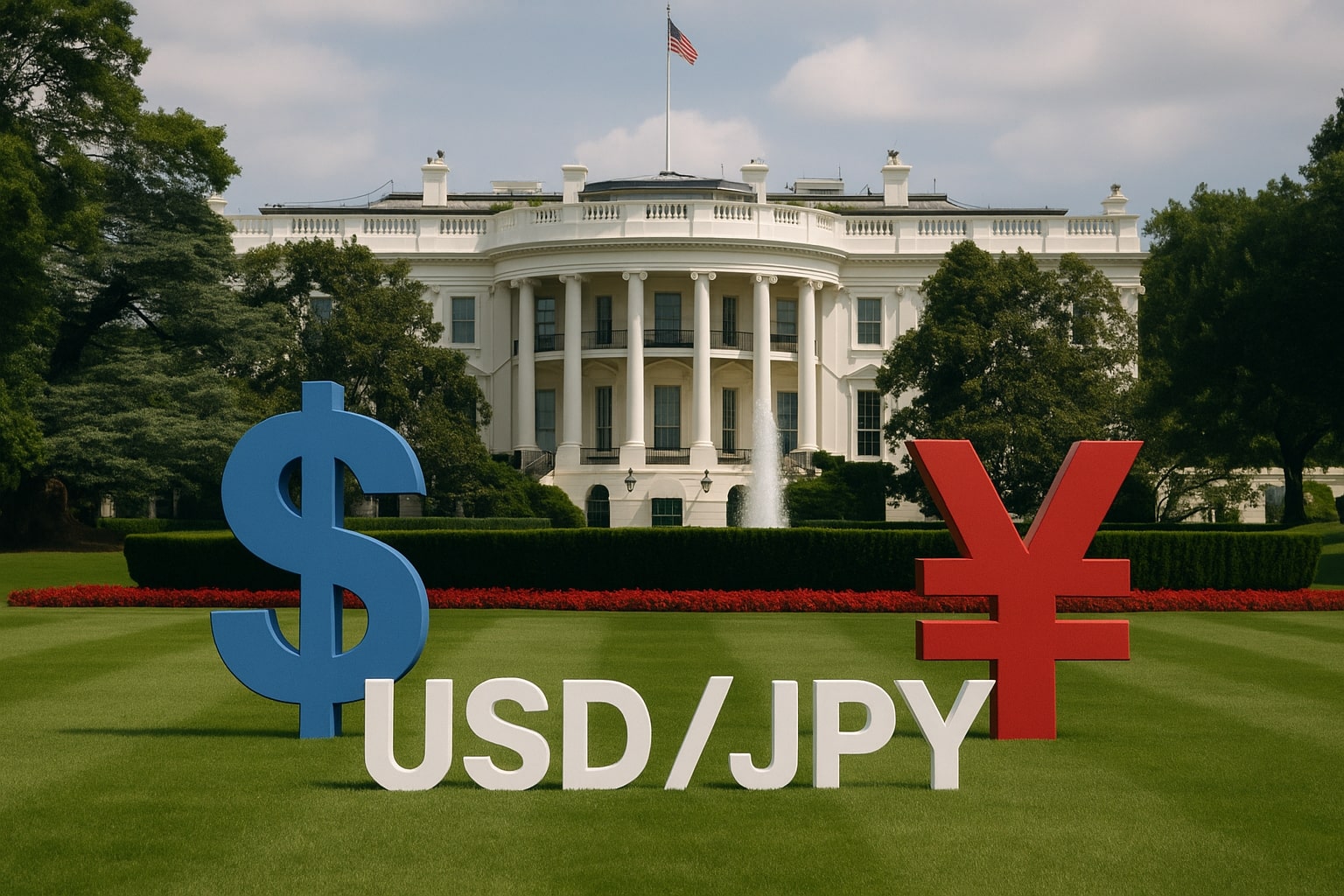
USD/JPY Faces Crucial Technical Levels Amid Global Yield Shifts
Are traders anticipating a major move in USD/JPY as the market grapples with the narrowing yield spread and global risk factors? Will the Fed’s next decision impact USD/JPY’s direction significantly? | That's TradingNEWS
USD/JPY Price: Navigating the Tight Range and Market Influences
The USD/JPY currency pair has faced significant fluctuations recently, reflecting the dynamic interplay between U.S. economic data, global interest rate expectations, and geopolitical tensions. Currently, USD/JPY is testing key technical levels, struggling to maintain bullish momentum amidst falling U.S. Treasury yields and a shift in market sentiment. As of the latest price action, USD/JPY is trading at 145.50, marking a retreat from its recent highs and signaling a pivotal moment in its short-term outlook.
Falling U.S. Treasury Yields Put Pressure on USD/JPY
The pullback in USD/JPY is directly linked to the decline in U.S. Treasury yields, particularly the 2-year and 10-year U.S. Treasury yields, which fell to 3.97% and 4.45%, respectively. This weakness in U.S. bond yields has diminished the appeal of the U.S. dollar, as investors typically demand higher yields to hold the currency. Consequently, USD/JPY has fallen towards 145.50, a critical support zone. The narrowing yield spread between U.S. Treasuries and Japanese Government Bonds (JGBs) adds further downside pressure on the U.S. dollar against the yen, potentially paving the way for more downside for the USD/JPY pair in the near term.
Bank of Japan’s Dovish Stance Fuels JPY Strength
On the other side of the spectrum, the Bank of Japan (BoJ) has maintained its dovish monetary policy, keeping interest rates at 0.5% while downgrading Japan’s growth forecast to 0.5% from the previously expected 1.1%. This dovish stance continues to weigh on the yen, though it remains less hawkish compared to expectations for the U.S. Federal Reserve. As of the most recent market updates, traders are still reacting to the BoJ's cautious approach to policy normalization, which has helped maintain a relatively strong JPY against a weaker USD. However, should the BoJ decide to alter its stance in the future, this could shift the balance in favor of the yen, bringing USD/JPY under further pressure.
Geopolitical Tensions and Safe-Haven Demand for JPY
In addition to interest rate differentials, USD/JPY is also sensitive to geopolitical risk, which often boosts the yen as a safe-haven asset. The ongoing tensions between the U.S. and China, along with the unresolved Russia-Ukraine conflict, have raised the level of global uncertainty, further fueling demand for the JPY. The yen is traditionally viewed as a safe-haven currency in times of geopolitical instability, and the current environment of heightened risk has contributed to its strength against the dollar. Despite this, USD/JPY has failed to make any significant upward moves, indicating a market in wait-and-see mode, waiting for clearer signals from both the U.S. Federal Reserve and Bank of Japan.
The Technical Picture: Support and Resistance Levels for USD/JPY
From a technical standpoint, the USD/JPY pair is trapped in a consolidation phase, with 145.50 acting as a key support level. A break below this level could open the door for a test of the 143.50–144.00 range, a critical area that has proven resilient in the past. Conversely, resistance at 146.00 continues to hold, and should USD/JPY clear this level, it would be poised for a test of higher resistance zones, possibly aiming towards 148.00 and beyond. However, the 50-day moving average at 145.43 remains a strong point of contention. If the pair settles below this line, it will likely experience further bearish momentum, targeting 143.50 next.
Fundamentals Behind USD/JPY Price Action
The broader economic context behind USD/JPY movements lies in the diverging policies of the U.S. Federal Reserve and the Bank of Japan. The Federal Reserve's recent economic data has softened its stance on rate hikes, with the latest Producer Price Index (PPI) report for April showing a 0.5% decline, well below the forecasted increase. Additionally, retail sales growth has slowed, adding further doubts about the robustness of the U.S. economy. As a result, traders are pricing in rate cuts from the Federal Reserve in 2025, which adds further downside pressure to the USD.
In contrast, the Bank of Japan's decision to hold steady with a dovish outlook reflects a commitment to its current monetary policy stance, despite inflationary pressures. The BoJ's growth forecast cut and its unwillingness to tighten rates have kept JPY strength limited in recent weeks. However, the BoJ has continued to support the economy through its expansive monetary policy, which may eventually lead to further strength for the yen if global risk factors persist.
Market Sentiment and Potential Risks for USD/JPY
The market sentiment surrounding USD/JPY has shifted recently, with traders focusing more on the narrowing interest rate gap between the U.S. and Japan, as well as the potential for further geopolitical risks to drive JPY strength. The recent U.S.-China trade truce has reduced some of the safe-haven demand for the USD, but with uncertainties surrounding trade negotiations and global growth, there are still plenty of risks for USD/JPY.
Moreover, the U.S. Dollar Index (DXY) has shown weakness, falling to key support levels, which may continue to drag USD/JPY lower. If USD/JPY fails to break above resistance at 146.00, traders may start to look for opportunities to short the pair, especially if global risk sentiment shifts back in favor of safe-haven currencies like the yen.
Interest Rate Outlook: Key Events to Watch for USD/JPY
Looking ahead, the USD/JPY pair’s fate largely depends on the upcoming decisions from both the Federal Reserve and Bank of Japan. With the Fed’s next meeting in June and the BoJ’s upcoming rate decision in mid-June, USD/JPY traders will be keeping a close eye on these events for any potential shifts in monetary policy. If the Fed cuts rates, the USD will likely continue its downward trajectory, and USD/JPY will be vulnerable to further losses. Conversely, if the BoJ shifts towards a more hawkish stance or signals tightening measures, JPY strength could accelerate, pushing USD/JPY lower.
In conclusion, the technical and fundamental landscape for USD/JPY is complex. The pair faces a critical juncture, with strong support at 145.50 and potential resistance at 146.00. Given the current market dynamics, USD/JPY remains highly sensitive to interest rate differentials and global geopolitical developments. While there are risks on both sides, the USD/JPY pair’s near-term direction will hinge on upcoming central bank decisions and any shifts in global sentiment. Traders should keep an eye on key levels and prepare for possible volatility as the pair navigates this uncertain period.
That's TradingNEWS
Read More
-
QDVO ETF (NYSEARCA:QDVO) Aims for $35 in 2025 and $42 in 2026 as AI Titans and 9.3% Yield Drive Record Performance
04.11.2025 · TradingNEWS ArchiveStocks
-
Ripple’s XRP ETFs XRPI and XRPR Rally Toward $25 as Institutional Demand and ETF Launch Momentum Lift XRP
04.11.2025 · TradingNEWS ArchiveCrypto
-
Natural Gas Price (NG=F) Extends Gains to $4.21 as Winter Demand and Record LNG Exports Fuel Bullish Momentum
04.11.2025 · TradingNEWS ArchiveCommodities
-
USD/JPY Price Forecast - JPY=X Holds Above 153.25 as Verbal Intervention Fails to Reverse Dollar Strength
04.11.2025 · TradingNEWS ArchiveForex



















